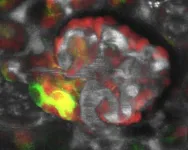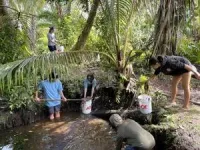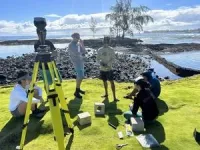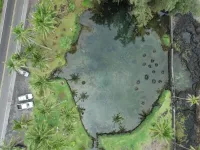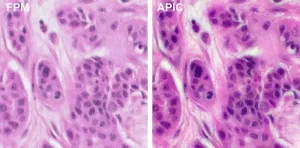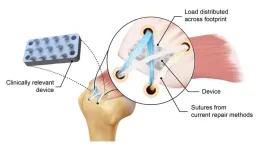(Press-News.org)
A loss of salt and body fluid can stimulate kidney regeneration and repair in mice, according to a NIH-funded study led by USC Stem Cell scientist Janos Peti-Peterdi and published in The Journal of Clinical Investigation. This innate regenerative response relies on a small population of kidney cells in a region known as the macula densa (MD), which senses salt and exerts control over filtration, hormone secretion, and other key functions of this vital organ.
“Our personal and professional mission is to find a cure for kidney disease, a growing global epidemic affecting one out of seven adults, which translates to 850 million people worldwide or about 2 million in the Los Angeles area,” said Peti-Peterdi, a professor of physiology, neuroscience and medicine at the Keck School of Medicine of USC. “Currently, there is no cure for this silent disease. By the time kidney disease is diagnosed, the kidneys are irreversibly damaged and ultimately need replacement therapies, such as dialysis or transplantation.”
To address this growing epidemic, Peti-Peterdi, first author Georgina Gyarmati, and their colleagues took a highly non-traditional approach. As opposed to studying how diseased kidneys fail to regenerate, the scientists focused on how healthy kidneys originally evolved.
“From an evolutionary biology perspective, the primitive kidney structure of the fish turned into more complicated and more efficiently working kidneys to absorb more salt and water,” said Peti-Peterdi, who also directs the Multi-Photon Microscopy Core at the Zilkha Neurogenetic Institute (ZNI). “This was necessary for adaptation to the dry land environment when the animal species moved from the salt-rich seawater. And that’s why birds and mammals have developed MD cells and this beautiful, bigger, and more efficient kidney structure to maintain themselves and functionally adapt to survive. These are the mechanisms that we are targeting and trying to mimic in our research approach.”
With this evolutionary history in mind, the research team fed lab mice a very low salt diet, along with a commonly prescribed drug called an ACE inhibitor that furthered lowered salt and fluid levels. The mice followed this regimen for up to two weeks, since extremely low salt diets can trigger serious health problems if continued long term.
In the region of the MD, the scientists observed regenerative activity, which they could block by administering drugs that interfered with signals sent by the MD. This underscored the MD’s key role in orchestrating regeneration.
When the scientists furthered analyzed mouse MD cells, they identified both genetic and structural characteristics that were surprisingly similar to nerve cells. This is an interesting finding, because nerve cells play a key role in regulating the regeneration of other organs such as the skin.
In the mouse MD cells, the scientists also identified specific signals from certain genes, including Wnt, NGFR, and CCN1, which could be enhanced by a low-salt diet to regenerate kidney structure and function. In keeping with these findings in mice, the activity of CCN1 was found to be greatly reduced in patients with chronic kidney disease (CKD).
To test the therapeutic potential of these discoveries, the scientists administered CCN1 to mice with a type of CKD known as focal segmental glomerulosclerosis. They also treated these mice with MD cells grown in low-salt conditions. Both approaches were successful, with the MD cell treatment producing the biggest improvements in kidney structure and function. This might be due to the MD cells secreting not only CCN1, but also additional unknown factors that promote kidney regeneration.
“We feel very strongly about the importance of this new way of thinking about kidney repair and regeneration,” said Peti-Peterdi. “And we are fully convinced that this will hopefully end up soon in a very powerful and new therapeutic approach.”
Additional co-authors are Urvi Nikhil Shroff, Anne Riquier-Brison, Dorinne Desposito, Audrey Izuhara, Sachin Deepak, Alejandra Becerra Calderon, James L. Burford, Hiroyuki Kadoya, Ju-Young Moon, Yibu Chen, Nariman Ahmadi, Berislav V. Zlokovic, and Inderbir S. Gill from USC; Wenjun Ju and Matthias Kretzler from the University of Michigan; Sean D. Stocker from the University of Pittsburgh School of Medicine; Markus M. Rinschen from the University of Cologne; Lester Lau from the University of Illinois at Chicago; Daniel Biemesderfer from Yale University School of Medicine; Aaron W. James from Johns Hopkins University; and Liliana Minichiello from the University of Oxford.
This work was federally funded by the National Institutes of Health (grants DK064324, DK123564, DK135290, S10OD021833, and 2P30-DK-081943) and further supported by an American Heart Association predoctoral research fellowship (grant 19PRE34380886).
Disclosure: Peti-Peterdi and Gyarmati are cofounders of Macula Densa Cell LLC, a biotechnology company that develops therapeutics to target MD cells for a regenerative treatment for CKD. Macula Densa Cell LLC has a patent entitled “Targeting macula densa cells as a new therapeutic approach for kidney disease” (US patents 10,828,374 and 11,318,209). Gill declares equity interest in OneLine Health and Karkinos.
END
A team of researchers from Ochsner Health recently published an insightful article in the International Forum of Allergy & Rhinology exploring the application of convolutional neural networks (CNNs) to improve the accuracy and efficiency of nasal endoscopy. The study, authored by resident physician Dr. Vinayak Ganeshan under the guidance of senior otolaryngologist Dr. Edward D. McCoul, addresses the challenges posed by the intricate nasal cavity anatomy in rhinology diagnostics.
Nasal endoscopy (NE) is an essential diagnostic tool in rhinology, but its effectiveness can be hampered by the complex ...
Scientists and kiaʻi loko (fishpond practitioners) have a new tool to aid their efforts to restore and ensure the resilience of Native Hawaiian fishponds. Researchers from the University of Hawai‘i (UH) and fishpond stewards in Hilo, Hawai‘i recently published a study in the Journal of Remote Sensing highlighting the use of uncrewed aerial vehicles (UAVs) to support integrated coastal zone management, including at cultural heritage sites.
“We discovered that drones are effective and cost-efficient ...
For hundreds of years, the clarity and magnification of microscopes were ultimately limited by the physical properties of their optical lenses. Microscope makers pushed those boundaries by making increasingly complicated and expensive stacks of lens elements. Still, scientists had to decide between high resolution and a small field of view on the one hand or low resolution and a large field of view on the other.
In 2013, a team of Caltech engineers introduced a microscopy technique called FPM (for ...
A Plano high school student conducting research in a University of Texas at Arlington chemistry professor’s lab earned multiple awards at the annual Regeneron International Science and Engineering Fair (ISEF). Regeneron ISEF is the world’s largest pre-college STEM competition for students in grades 9-12.
Chloe Lee, a junior in the International Baccalaureate program at Plano East Senior High School, conducted research in the lab of Junha Jeon, associate professor of chemistry and ...
“The deployment of DL segmentation methods in 18F-fluciclovine PET/CT imaging represents an intriguing research direction for precision medicine in salvage prostate cancer care.”
BUFFALO, NY- June 28, 2024 – A new editorial paper was published in Oncoscience (Volume 11) on May 20, 2024, entitled, “Deep learning-assisted lesion segmentation in PET/CT imaging: A feasibility study for salvage radiation therapy in prostate cancer.”
In this new editorial, researchers Richard L.J. Qiu, Chih-Wei Chang, ...
An A-list of researchers from across USC is building a dementia cost model that will generate comprehensive national, annual estimates of the cost of dementia that could benefit patients and their families, thanks to a five-year, $8.2 million federal grant from the National Institute on Aging.
A firm grip on the costs of the disease could assist families living with dementia with planning their budgets and support needs, inform treatment and caregiving options, and help shape health care policy.
“We currently have estimates for a particular ...
TAMPA, Fla. — Withanolides, a class of naturally occurring compounds found in plants, have long been a focus of cancer research due to their ability to inhibit cancer cell growth, induce cell death and prevent metastasis. These compounds are important in developing new cancer treatments. However, the difficulty of obtaining enough of these compounds from plants has hindered research and therapeutic development.
Moffitt Cancer Center researchers have developed a groundbreaking method for the scalable synthesis of withanolides. This innovative approach, published in Science Advances, could revolutionize cancer research by providing ...
PROVIDENCE, R.I. [Brown University] — NASA’s Mars InSight Lander may be resting on the Red Planet in retirement, but data from the robotic explorer is still leading to seismic discoveries on Earth.
In one of the latest studies using data from the spacecraft, an international team of scientists led by a Brown University researcher found that Mars may be getting bombarded by space rocks at more frequent rates than previously thought. Impact rates could be two to 10 times higher than previously estimated, depending on the size of the meteoroids, according to the study published in Science Advances.
“It’s ...
Researchers at Baylor College of Medicine, the University of Cambridge in the U.K. and collaborating institutions have shown that serotonin 2C receptor in the brain regulates memory in people and animal models. The findings, published in the journal Science Advances, not only provide new insights into the factors involved in healthy memory but also in conditions associated with memory loss, like Alzheimer’s disease, and suggest novel avenues for treatment.
“Serotonin, a compound produced by neurons in the midbrain, acts as a neurotransmitter, passing messages between brain cells,” said co-corresponding author Dr. Yong Xu, professor of pediatrics ...
New York, NY—June 24, 2024—Most people, when they think about pythons, visualize the huge snake constricting and swallowing victims whole. But did you know that pythons initially hold onto their prey with their sharp, backward-curving teeth? Medical researchers have long been aware that these teeth are perfect for grasping soft tissue rather than cutting through it, but no one has yet been able to put this concept into surgical practice. Over the years, mimicking these teeth for use in surgery has been a frequent topic ...
